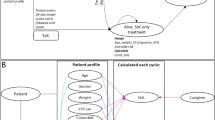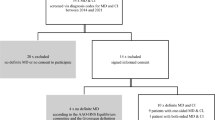Abstract
Background
In the US, a child born deaf with abnormal inner ear anatomy and for whom a cochlear implant fails to provide benefit has no approved surgical treatment options. The auditory brainstem implant (ABI) was developed in the US for patients with Neurofibromatosis 2. A European surgical team has advanced ABI use in young children, with promising outcomes. Clinical teams face a number of challenges, from regulatory issues to funding. The strategic decisions leading to the safety and early efficacy protocol of the ABI for young children with congenital deafness are described.
Methods
A sponsor-investigator pre–Investigational Device Exemption (IDE) was significantly altered in discussion with the Food and Drug Administration (FDA), followed by approval of a revised protocol. A critical step involved securing external funding through an NIH U01 clinical trial grant, and enrollment began in 2014.
Early Results
The protocol focused on strict inclusion criteria, clear stopping rules, and rigorous interim safety data review before proceeding with enrollment. To date, 4 of the 7 enrolled subjects met criteria for implantation. A single expected serious adverse event occurred, which resolved completely without sequela.
Conclusions
Promising innovative treatments face a number of obstacles along the pathway to full commercialization. A strategy that included early conversations with the FDA and the device manufacturer, and successfully obtaining external funding, resulted in an approved IDE protocol. Early results indicated that the risks, though not minimal, can be successfully mitigated. These young children appear to benefit audiologically from the ABI.
Similar content being viewed by others
References
Sennaroglu L, Ziyal I. Auditory brainstem implantation. Auris Nasus Larynx. 2012;39:439–450.
Roland P, Henion K, Booth T, et al. Assessment of cochlear implant candidacy in patients with cochlear nerve deficiency using the P1 CAEP biomarker. Cochlear Implants Int. 2012;13:16–25.
Cunningham M, Cox EO. Hearing assessment in infants and children: recommendations beyond neonatal screening. Pediatrics. 2003;111:436–440.
Coticchia JM, Gokhale A, Waltonen J, et al. Characteristics of sensorineural hearing loss in children with inner ear anomalies. Am J Otolaryngol. 2006;27:33–38.
Otto SR, Brackmann D, Hitselberger W, et al. Multichannel auditory brainstem implant: update on performance in 61 patients. J Neurosurg. 2002;96:1063–1071.
Nevison B, Laszig R, Sollman WP, et al. Results from a European Clinical Investigation of the Nucleus® Multichannel Auditory Brainstem Implant. Ear Hear. 2002;23:170–183.
Colletti V, Fiorino F, Carner M, et al. Auditory brainstem implantation: The University of Verona experience. Otolaryngol Head Neck Surg. 2002;127:84–96.
Colletti V, Fiorino F, Sacchetto L, et al. Hearing habilitation with auditory brainstem implantation in two children with cochlear nerve aplasia. Int J Pediatr Otorhinoloaryngol. 2001;60:99–111.
Colletti V. Auditory outcomes in tumor vs. nontumor patients fitted with auditory brainstem implants. Adv Otorhinolaryngol. 2006;64:167–185.
Colletti V, Fiorino FG, Carner M, et al. Auditory brainstem implant as a salvage treatment after unsuccessful cochlear implantation. Otol Neurotol. 2004;25:485–496; discussion 496.
Tan VY, D’Souza VD, Low WK. Acoustic brainstem implant in a post-meningitis deafened child—lessons learned. Int J Pediatr Otorhinolaryngol. 2012;76:300–302.
Otto SR, Waring M, Kuchta J. Neural response telemetry and auditory/non-auditory sensations in 15 recipients of auditory brainstem implants. J Am Acad Audiol. 2005;16:219–227.
Goffi-Gomez MV, Magalhaes AT, Brito Neto R., et al. Auditory brainstem implant outcomes and MAP parameters: report of experiences in adults and children. Int J Pediatr Otorhinolaryngol. 2012;76:257–264.
Behr R, Briggs R, Cohen N, et al. Consensus statement of the ABI advisory group. J Laryngol Otol. 2000;114(suppl 27):2.
Sennaroglu L, Colletti V, Manrique M, et al. Auditory brainstem implantation in children and non-neurofibromatosis type 2 patients: a consensus statement. Otol Neurotol. 2011;32:187–191.
Tysome JR, Axon PR, Donnelly NP, et al. English consensus protocol evaluating candidacy for auditory brainstem and cochlear implantation in neurofibromatosis type 2. Otol Neurotol. 2013;34:1743–1747.
Sennaroglu L, Sennaroglu G, Atay G. Auditory brainstem implantation in children. Curr Otorhinolaryngol Rep. 2013;1:80–91.
Bowen DJ, Kreuter M, Spring B, et al. How we design feasibility studies. Am J Prev Med. 2009;36:452–457.
Papsin B. Cochlear implantation in children with anomalous cochleovestibular anatomy. Laryngoscope. 2005;115(suppl):1–26.
Buchman C, Teagle HFB, Roush PA, et al. Cochlear implantation in children with labyrinthine anomalies and cochlear nerve deficiency: implications for auditory brainstem implantation. Laryngoscope. 2011;121:1979–1988.
Johnson KC, Wiley S. Cochlear implantation in children with multiple disabilities. In:Eisenberg L, ed. Clinical Management of Children With Cochlear Implants. San Diego, CA: Plural Publishing Inc; 2009.
FDA. Guidance for industry and Food and Drug Administration staff: Factors to consider when making benefit-risk determinations in medical device premarket approval and de novo classifications. Silver Spring, MD: FDA; 2012.
Young NM, Kim FM, Ryan ME, et al. Pediatric cochlear implantation of children with eighth nerve deficiency. Int J Pediatr Otorhinolaryngol. 2012;76:1442–1448.
Kaplan AB, Kozin ED, Puram SV, et al. Auditory brainstem implant candidacy in the United States in children 0–17 years old. Int J Pediatr Otorhinolaryngol. 2015;79:310–315.
Colletti V, Carner M, Miorelli V, et al. Auditory brainstem implant (ABI): new frontiers in adults and children. Otolaryngol Head Neck Surg. 2005;133:126–138.
Sharma A, Dorman M, Spahr A, et al. Early cochlear implantation in children allows normal development of central auditory pathways. Ann Otol Rhinol Laryngol Suppl. 2002;189:38–41.
Swingley D, Aslin RN. Spoken word recognition and lexical representation in very young children. Cognition. 2000;76:147–166.
Eisenberg LS, Johnson KC, Martinez AS, et al. Studies in pediatric hearing loss at the House Research Institute. J Am Acad Audiol. 2012;23:412–421.
Eisenberg LS, Johnson KC, Martinez AS, et al. Comprehensive evaluation of a child with an auditory brainstem implant. Otol Neurotol. 2008;29:251–257.
Watkin P, McCann D, Law C, et al. Language ability in children with permanent hearing impairment: the influence of early management and family participation. Pediatrics. 2007;120:e694–e701.
Li D, Wang H, Fan Z, et al. Complications in retrosigmoid cranial nerve surgery. Acta Otolaryngol. 2010;130:247–252.
Schwartz MS, Otto SR, Shannon RV, et al. Auditory brainstem implants. Neurotherapeutics. 2008;5:128–136.
Kim JP, Chung JC, Chang WS, et al. Surgical complications of pediatric auditory brain stem implantation in patients with narrow internal auditory canal following retrosigmoid approach. Childs Nerv Syst. 2012;28:933–938.
Colletti V, Shannon RV, Carner M, et al. Complications in auditory brainstem implant surgery in adults and children. Otol Neurotol. 2010;10:558–564.
Baroncini M, Thines L, Reyns N, et al. Retrosigmoid approach for meningiomas of the cerebellopontine angle: results of surgery and place of additional treatments. Acta Neurochir (Wien). 2011;153:1931–1940; discussion 1940.
Teo MK, Eljamel MS. Role of craniotomy repair in reducing postoperative headaches after a retrosigmoid approach. Neurosurgery. 2010;67:1286–1291; discussion 1291–1292.
FDA. Leveraging Existing Clinical Data for Extrapolation to Pediatric Uses of Medical Devices: Draft Guidance. Rockville, MD: USDHHS, FDA, Center for Devices and Radiological Health, Center for Biologics Evaluation and Research; 2015.
Nevison B. A guide to the positioning of brainstem implants using intraoperative electrical auditory brainstem responses. Adv Otorhinolaryngol. 2006;64:154–166.
O’Driscoll M, El-Deredy W, Ramsden R. Brain stem responses evoked by stimulation of the mature cochlear nucleus with an auditory brain stem implant. Ear Hear. 2011;32:286–299.
O’Driscoll M, El-Deredy W, Atas A, et al. Brain stem responses evoked by stimulation with an auditory brain stem implant in children with cochlear nerve aplasia or hypoplasia. Ear Hear. 2011;32:300–312.
Waring MD. Intraoperative electrophysiologic monitoring to assist placement of auditory brainstem implant. Ann Otol Rhinol Laryngol Suppl. 1995;166:33–36.
Author information
Authors and Affiliations
Consortia
Corresponding author
Additional information
Author Note
The members of the Los Angeles Pediatric ABI Team are as follows: Keck School of Medicine of University of Southern California: Laurie S. Eisenberg, PhD, Co-Principal Investigator, Robert V. Shannon, PhD, Co-Investigator, Laurel M. Fisher, PhD., Co-Investigator, Amy S. Martinez, MA, Research Audiologist, Clinical Coordinator, Margaret Winter, MS, Lead ABI Audiologist, Jamie Glater, AuD, ABI Audiologist, Dianne Hammes-Ganguly, MA, Speech Language Pathologist, Debra Schrader, Educational Liaison. Children’s Hospital Los Angeles: Mark Krieger, MD, Chief, Pediatric Neurosurgery. Huntington Medical Research Institutes, House Clinic: Eric P. Wilkinson, MD, Co-Principal Investigator, Marc S. Schwartz, MD, Neurosurgeon
Rights and permissions
About this article
Cite this article
Fisher, L.M., Eisenberg, L.S., Krieger, M. et al. Regulatory and Funding Strategies to Develop a Safety Study of an Auditory Brainstem Implant in Young Children Who Are Deaf. Ther Innov Regul Sci 49, 659–665 (2015). https://doi.org/10.1177/2168479015599559
Received:
Accepted:
Published:
Issue Date:
DOI: https://doi.org/10.1177/2168479015599559




